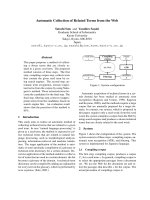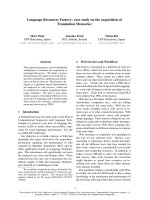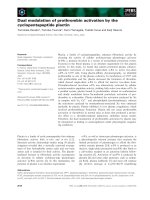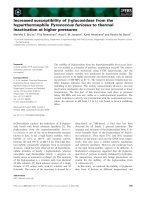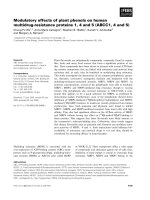báo cáo khoa học: "Long-term survivor of relapsed MFH on the thigh treated with autologous formalin-fixed tumor vaccine (AFTV) combined with limb-sparing surgery and radiotherapy" doc
Bạn đang xem bản rút gọn của tài liệu. Xem và tải ngay bản đầy đủ của tài liệu tại đây (1.36 MB, 4 trang )
CAS E REP O R T Open Access
Long-term survivor of relapsed MFH on the thigh
treated with autologous formalin-fixed tumor
vaccine (AFTV) combined with limb-sparing
surgery and radiotherapy
Takeshi Todoroki
1*
, Tadashi Kondo
2
, Shinji Sugahara
3
, Yukio Morishita
4
, Kensaku Mori
5
and Tadao Ohno
6
Abstract
Malignant fibrous histiocytoma (MFH) is an aggressive spindle cell cancer of soft-tissue sarcoma type in the elderly,
mostly affecting the extremities. Lesions > 5 cm, positive margins, and local recurrence are significant poor
prognostic indicators. The strongest predictor for distant metastasis was tumor size (> 5 cm), and for overall
survival, presence of local recurrence. Limb-sparing extensive tumor resection is preferred to achieve negative
surgical margins. However, in some circumstances, amputation is inevitable. Recent studies demonstrated that
adjuvant radiotherapy for microscopically positive surgical margins significantly improved local control and disease-
free survival rates. Therefore, effective therapeutic strategies against locally relapsed high grade MFH are required
to prevent distant metastasis and to achieve long-term disease-free survival. Here, we report local relapse of high
grade MFH treated by successive application of autologous formalin-fixed tumor vaccination (AFTV) with limb-
sparing surgery and postoperative radiotherapy. The patient is alive and well, disease-free and with no functional
impairment, more than five years after treatment.
Background
Malignant fibrous histiocytoma (MFH) is the most com-
mon soft-tissu e sarcoma. When located in a limb, MFH
is currently treated with limb-sparing surgery followed
by > 65 Gy external beam radiotherapy [1,2]. For
patients with locally recurrent large tumors (> 5 cm in
diameter) on the thigh, limb-sparing surgery with ade-
quate clearance margins is desirable but not always
attainable. Additionally, large tumors often result in dis-
tant metastasis [1], for which there is currently no effec-
tive chemotherapy [2]. Patients thus face amputation for
complete tumor removal; so improved treatment options
are urgently required for locally recurrent high-grade
MFH. Here, we report application of autologous forma-
lin-fixed tumor vaccination (AFTV) combined with
limb-spar ing surgery and followed by anticipatory 74 Gy
external electron beam radiotherapy in an elderly dia-
betic patient with locally recurrent MFH after primary
limb-sparing surgery. The vaccine was prepared from
both the recurrent and the primary tumor after limb-
sparing surgery [3].
Case report
A 72-year old man presented with a painful ulcerative
tumor (4.5 cm) at the location of a scar on the right
thigh, where a mass 7.5 cm in diameter had been
resected at a different clinic three months e arlier. No
pathological information was available at the time, but
because of the painful infected lesion, we promptly
removed the tumor, which had cloudy exudates at the
ulcerative surface. The patie nt had suffered > 5 years
from poorly controlled diabetes mellitus (DM) with
blood sugar at 272 mg/dl and an ele vated HbA1C of
9.4%, but no ketone bodies in the urine. Other labora-
tory tests revealed signs of slight inflammation, includ-
ing a WBC of 6,540/mm
3
and a CR P of 0.35 mg/dl. We
removed the tumor with 1.5 cm horizontal margins, pre-
serving the fascia lata. DM was treated orally. Patho logi-
cal examination revealed that the mass was a malignant
* Correspondence:
1
Department of Surgery, Tsukuba Central Hospital, Ushiku- shi 300-121, Japan
Full list of author information is available at the end of the article
Todoroki et al. World Journal of Surgical Oncology 2011, 9:96
/>WORLD JOURNAL OF
SURGICAL ONCOLOGY
© 2011 Todoroki et al; licensee Bi oMed Central Ltd. This is an Open Access article distributed under the terms of the Creative
Commons Attr ibution License (http ://creativecom mons.org/licenses/by/2.0), which permits unrestricted use, distributio n, and
reproduction in any medium, provided the original work is properly cited.
fibrous histiocytoma (MFH) composed of strongly pro-
liferating fibroblastic and histiocytic tumor cells with
bizarre nuclei, abundant mitotic activity, a pleomorphic
pattern and necrotic areas. These findings were identical
in the primary extirpated tumor (7.5 cm) reported in
the meantime by the previous clinic (Figure 1). This cor-
responds to the UICC classification of high grade (G3-
deep) MFH, stage III [4]. Because pathology showed
that the vertical surgical margin was positive, magnetic
resonance imaging (MRI) and positron emission com-
puted tomography (PET-CT) was undertaken 5 weeks
after surgery. This revealed small mass at the vertical
surgical margin, but no metastatic lesions (Figure 2).
Beginning 6 weeks after the second tumor removal, elec-
tron beam adjuvant radiotherapy using a s hrinking field
technique was used to deliver a total dose of 74 Gy in
fractions of 2.0 Gy over 5 consecutive days per week
(Figure 3). Ini tial 6 MV X-ray was irradiated by using
lateral opposed field with 15-degree wedge filter and 5
mm bolus to surgical scar and tumor bed up to 50 Gy/
25 fractions/5 weeks. After that, 24 Gy/12 fractions/2.4
weeks of irradiation was delivered to surgical scar with
6 MeV electron beam as a boost. Paraffin-embedded
primary tumor and t he formalin-fixed recurrent tumor
were injected intradermally three times every two weeks
as AFTV. Delayed-type hypersensitivity (DTH) testing
both before the first injection and 48 hours later was
negative. DTH two weeks after the final AFTV injection
was judged pseudo-positive (Figure 4). Immu ne para-
meters after treatm ent were normalized (Additional File
1). The treatment course was uneventful; there were no
adverse effects. Around 5 years after the primary limb-
sparing surgery the patient remains well with no evi-
dence of metastasis or local recurrence (Figure 5) and
the third DTH test performed around 4 years after
AFTV was apparently positive (Figure 6).
Discussion and conclusions
Combining limb-sparing surgery and post operative
radiotherapy with > 65 Gy is standard treatment for
patients with high grade large MFH [1]. Treatment of
local recurrence of such tumors would also require
Figure 1 microscopic photograps (HE: X200). Primary (left) and
Recurrent (right) tumors are consisted of proliferative fibroblastoid
cells, bizarre nucleated cells with high mitotic activity and partially
necrotic areas.
Figure 2 MRI & PET-CT.A:MRIimagedemonstratesasmall
recurrent tumor on the vertical surgical margin at the fascia lata of
the right thigh. B: PET-CT mages in coronary (1) and sagittal (2)
sections of the right thigh and hot spots indicate the recurrent
tumor.
Figure 3 Post-operative radiation fields. Post-operative radiation
fields in shrinking field technique.
Figure 4 Autologuos tumor specific delayed type
hypersensitivity test (DTH). White arrow indicates pseudo-positive
reaction.
Todoroki et al. World Journal of Surgical Oncology 2011, 9:96
/>Page 2 of 4
systemic adjuvant therapy to prevent distant metastasis.
However, no effective chemotherapeuti c regimen exists.
Here, we applied AFTV from the start of postoperative
radiotherapy instead of chemotherapy, in consideration
of the patient’s uncontrolled DM. Details of the AFTV
have already been reported [5]. We used a mixture of
both paraffin-embedded primary tumor and formalin-
fixed secondary t umor as the vaccine. In this way, we
aimed to include the original tumor antigens in the pri-
mary tumor as well as any possible alterations of the
expressed tumor antigens in the progressive metastatic
tumor cells. The object ive was to eradi cate the micro-
scopically observed tumor cells remaining after surgery
and irradiation. Hafner et al. reported that decreased
immune surveillance might play a role in the develop-
ment of MFH, based on a significant increase in its
incidence in a large series of renal transplant patients
(156 per 100,000) [ 6]. This was another reason to
attempt AFTV rather than chemotherapy. Even in the
present time, there is no clinically appropriate e stimat-
ing system of antitumor cellular immune reactivity for
the particular patient. Since DTH testing is commonly
used to measure specific antitumor cellular immune
reactivity we used it to evaluate antitumor cellular
immune status in the different timing as just before,
complete, and late after AFTV. The reactivity has
strengthened from pseudo and true positive during 4
years after AFTV in the reported case. Radiation therapy
of 74 Gy by using shrinking field technique has very
efficiently controlled locally relapse hig h grade MFH. As
conclusion, results for the case reported here s uggest
that AFTV in combination with limb-sparing surgery
and adjuvant radiotherapy might extend survival of
patients with locally advanced high grade MFH of extre-
mities with enhancing specific antitumor immune
reactivity.
Consent
Written consent was obtained from the patient for pub-
lica tion of this case report and accompanying images. A
copy of the written consent is available for review by
the Editor-in-Chief of this journal.
Additional material
Additional file 1: Table1. Immune Parameters 2 wk after completion of
AFTV.
Author details
1
Department of Surgery, Tsukuba Central Hospital, Ushiku- shi 300-121, Japan.
2
Department of Surgery, Tsukuba University, Tsukuba-Shi 305-8575, Japan.
3
Department of Therapeutic Radiology, Tsukuba University, Tsukuba-Shi 305-
8575, Japan.
4
Clinical Pathology, Tsukuba University, Tsukuba-S hi 305-8575,
Japan.
5
Diagnostic Radiology of Tsukuba University, Tsukuba-Shi 305-8575,
Japan.
6
Cell-Medicine Inc. Tsukuba-Shi 305-0047, Japan.
Authors’ contributions
TK carried out postoperative wound care. SS participated in the
postoperative radiotherapy. MT participated in the pathological studies. KM
participated in the radiological imaging studies. TO participated in preparing
AFTV treatment design and coordination. All authors read and approved the
final manuscript.
Competing interests
The authors declare that they have no competing interests.
Received: 19 July 2010 Accepted: 24 August 2011
Published: 24 August 2011
References
1. Delaney TF, Kepka L, Goldberg SI, Hornicek FJ, Gebhardt MC, Yoon SS,
Springfield DS, Raskin KA, Harmon DC, Kirsch DG, et al: Radiation therapy
for control of soft-tissue sarcomas resected with positive margins. Int J
Radiat Oncol Biol Phys 2007, 67:1460-1469.
Figure 5 Coronary sections of MRI and PET-CT, and
Photograph on the right thigh. No tumor exist 30 months after
treatments on these images.
Figure 6 Positive DTH test. Positive DTH test performed around 4
years after completion of AFTV.
Todoroki et al. World Journal of Surgical Oncology 2011, 9:96
/>Page 3 of 4
2. Hohenberger P, Wysocki WM: Neoadjuvant treatment of locally advanced
soft tissue sarcoma of the limbs: which treatment to choose? Oncologist
2008, 13:175-186.
3. Liu SQ, Shiraiwa H, Kawai K, Hayashi H, Akaza H, Kim BS, Oki A, Nishida M,
Kubo T, Hashizaki K, et al: Tumor-specific autologous cytotoxic T
lymphocytes from tissue sections. Nat Med 1996, 2:1283.
4. Edge SB, Compton CC: The American Joint Committee on Cancer: the
7th edition of the AJCC cancer staging manual and the future of TNM.
Ann Surg Oncol 2010, 17:1471-1474.
5. Ishikawa E, Tsuboi K, Yamamoto T, Muroi A, Takano S, Enomoto T,
Matsumura A, Ohno T: Clinical trial of autologous formalin-fixed tumor
vaccine for glioblastoma multiforme patients. Cancer Sci 2007,
98:1226-1233.
6. Hafner J, Kunzi W, Weinreich T: Malignant fibrous histiocytoma and
atypical fibroxanthoma in renal transplant recipients. Dermatology 1999,
198:29-32.
doi:10.1186/1477-7819-9-96
Cite this article as: Todoroki et al.: Long-term survivor of relapsed MFH
on the thigh treated with autologous formalin-fixed tumor vaccine
(AFTV) combined with limb-sparing surgery and radiotherapy. World
Journal of Surgical Oncology 2011 9:96.
Submit your next manuscript to BioMed Central
and take full advantage of:
• Convenient online submission
• Thorough peer review
• No space constraints or color figure charges
• Immediate publication on acceptance
• Inclusion in PubMed, CAS, Scopus and Google Scholar
• Research which is freely available for redistribution
Submit your manuscript at
www.biomedcentral.com/submit
Todoroki et al. World Journal of Surgical Oncology 2011, 9:96
/>Page 4 of 4


